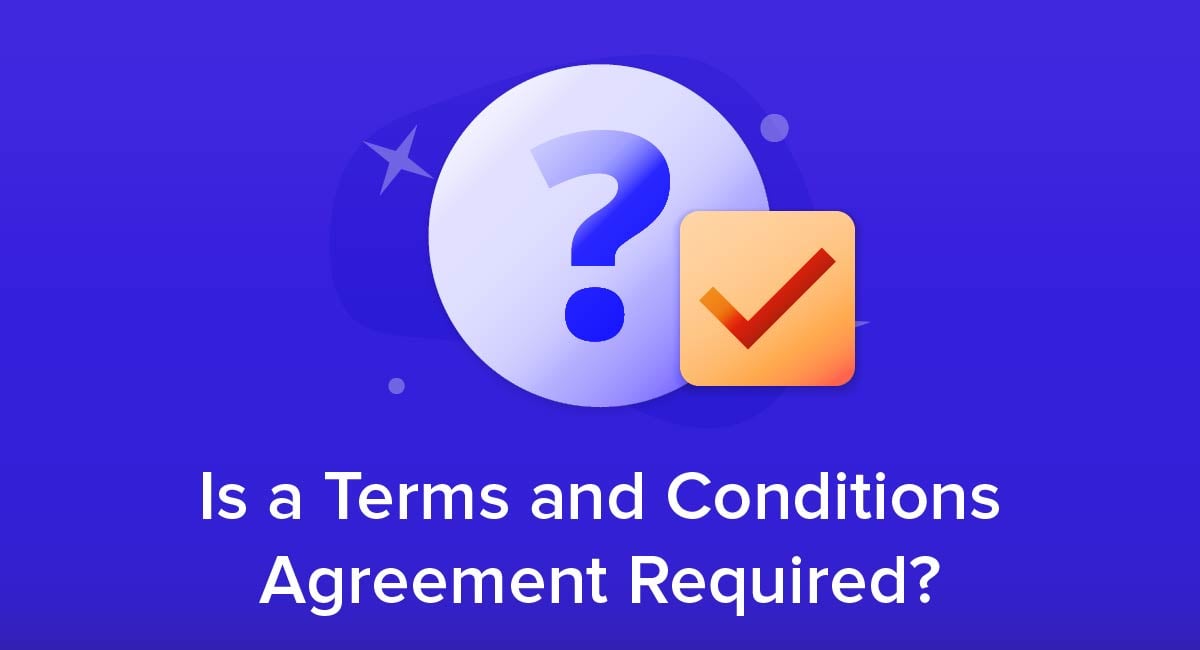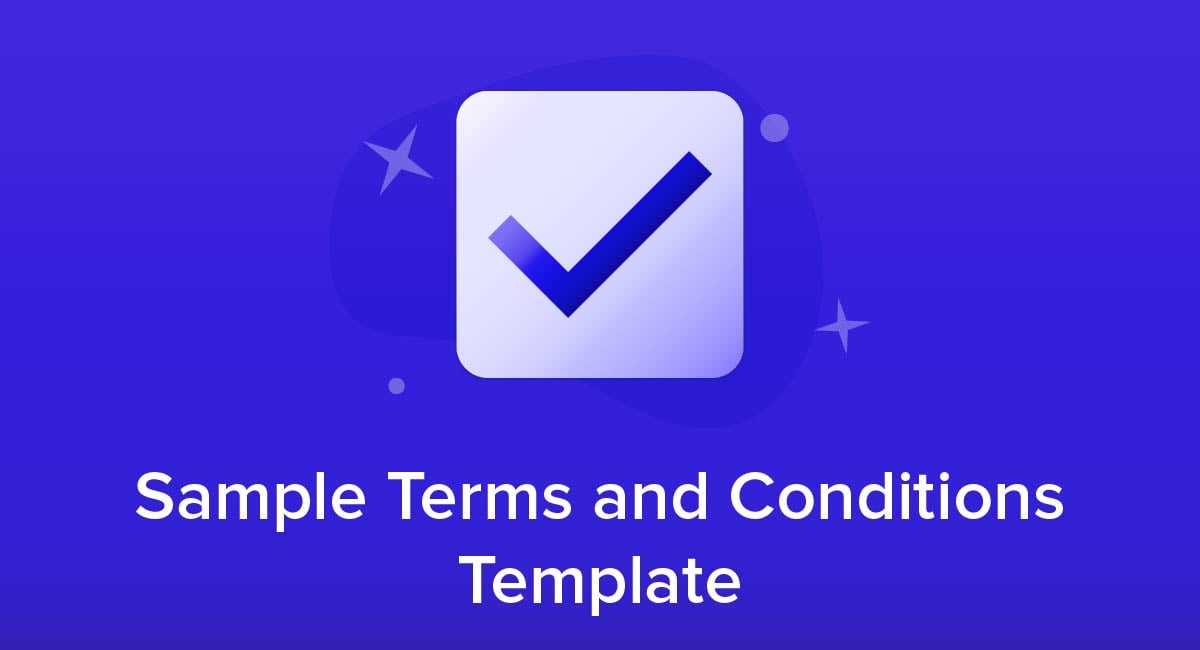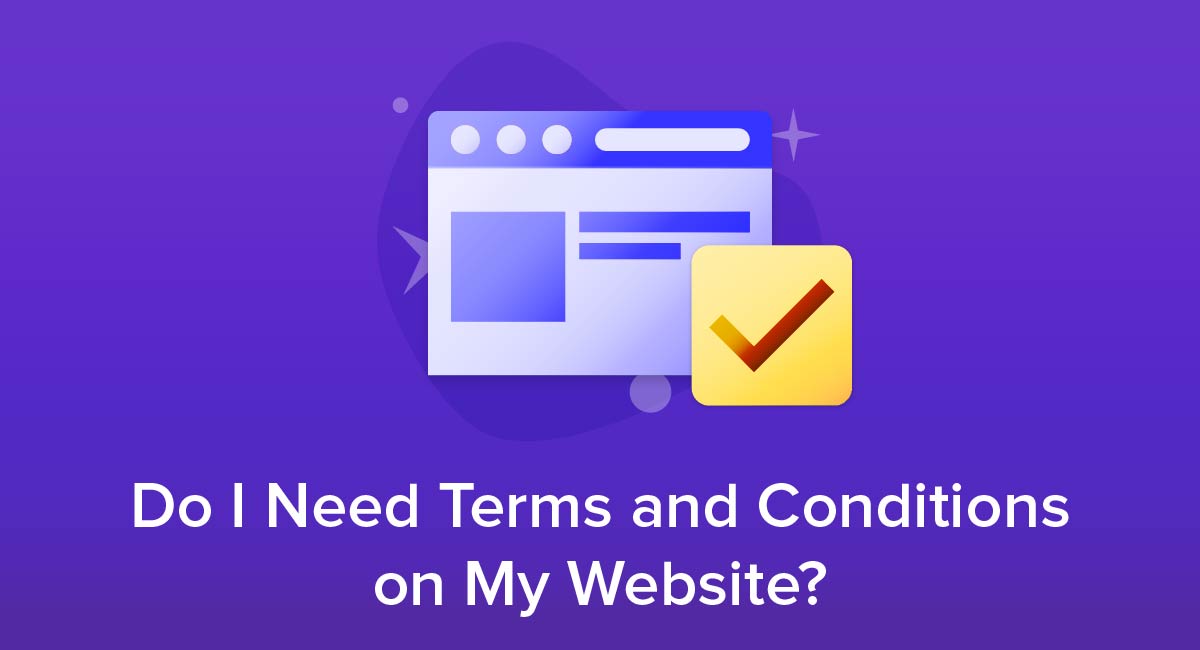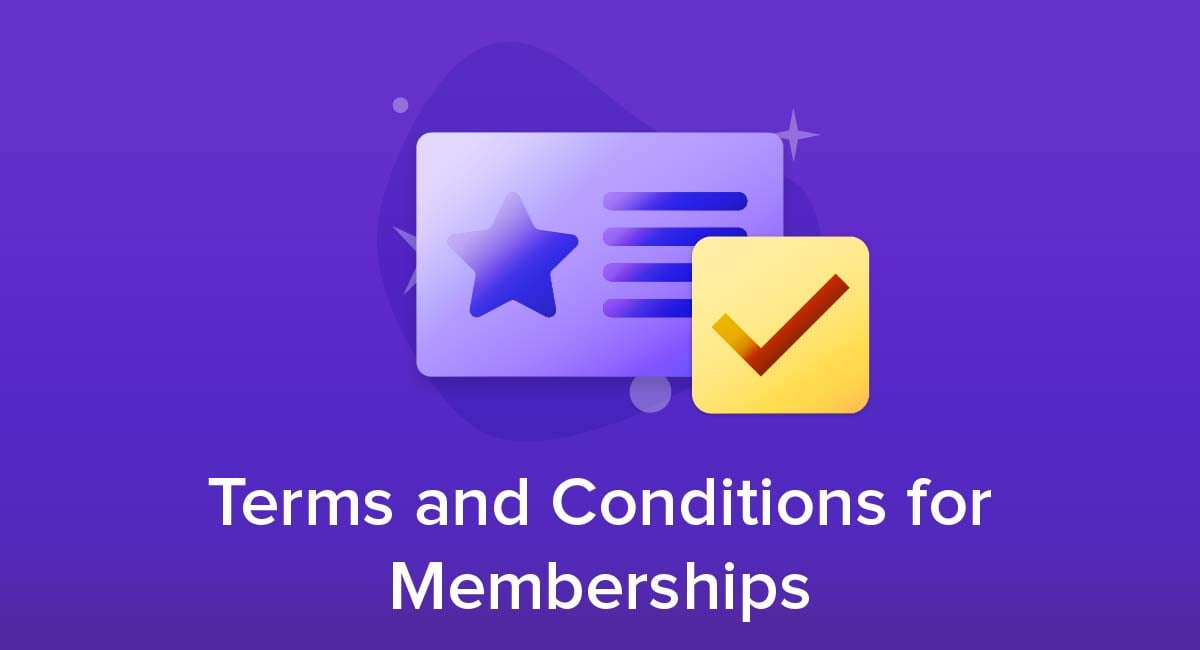
A membership program involves a business relationship between you and your customers. A Terms and Conditions agreement sets out the ground rules for that relationship and should address many of the potential disputes that could arise.
While some clauses are standard in all Terms and Conditions agreements, you also need to address some specific points that come up with a membership relationship. Here's what you need to know about having and creating a Terms and Conditions agreement for memberships.
Our Free Terms and Conditions Generator is created to help you generate a professionally drafted agreement that can include various terms and conditions for your site and/or app.
- Start the Free Terms and Conditions Generator from our website.
- Select platforms where your Terms and Conditions will be used (website, app or both):
- Answer a few questions about your website or app information:
- Select the country:
- Answer a few questions about your business practices:
-
Enter your email address where you'd like to receive the new Free Terms and Conditions and click "Generate":
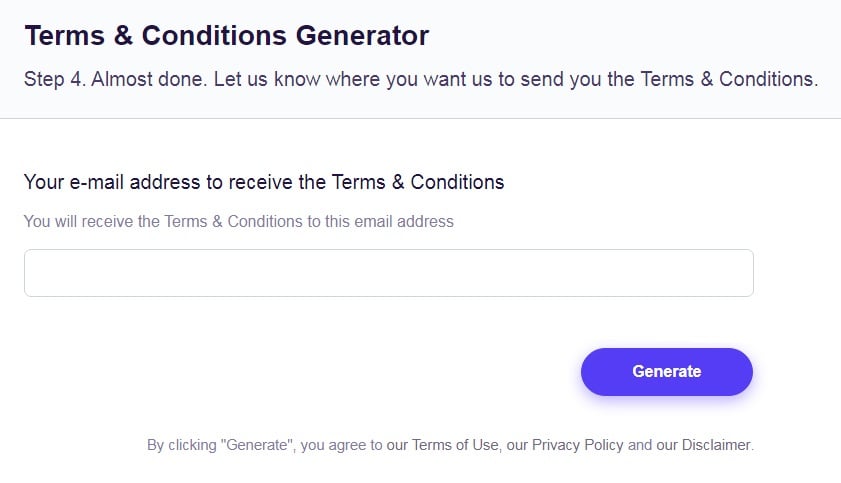
Once generated, you can copy and paste your Free Terms and Conditions agreement on your website or app or link to your hosted Free Terms and Conditions page.
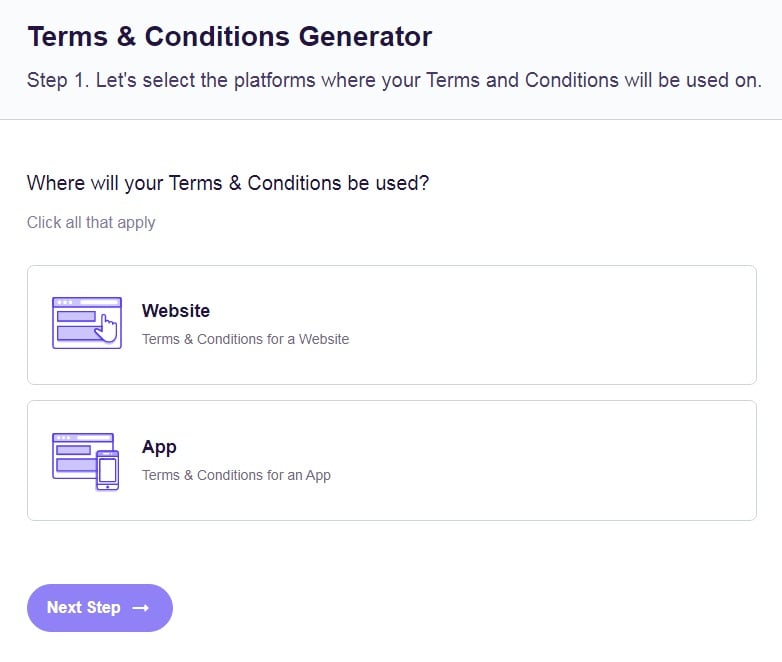
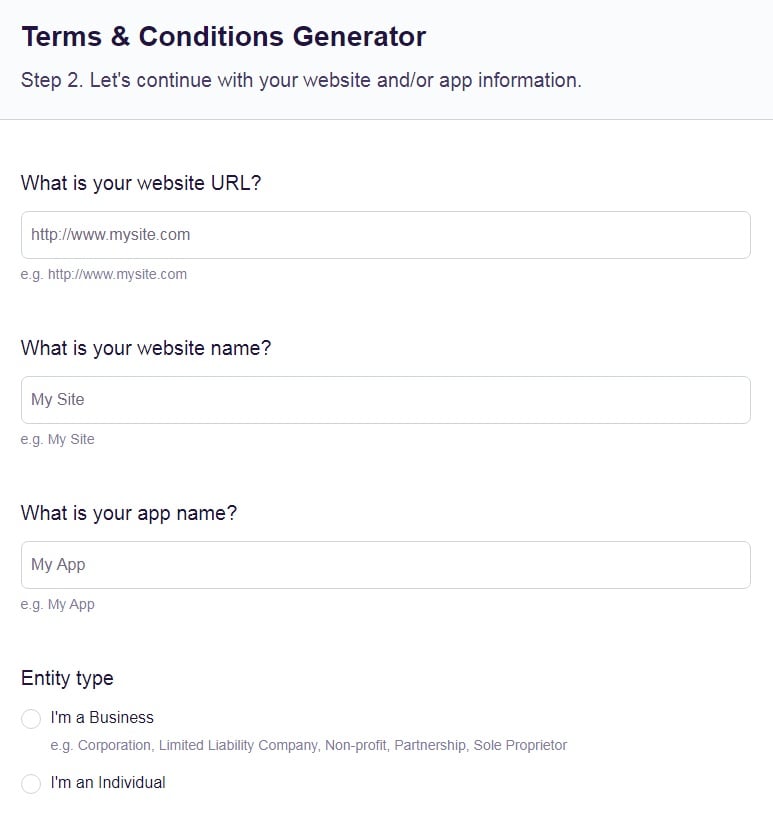
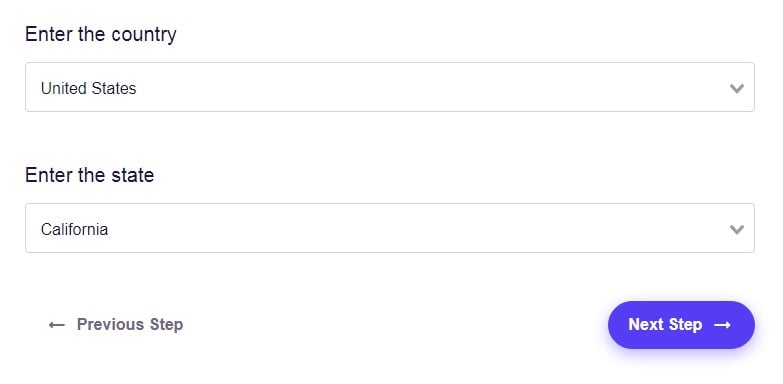
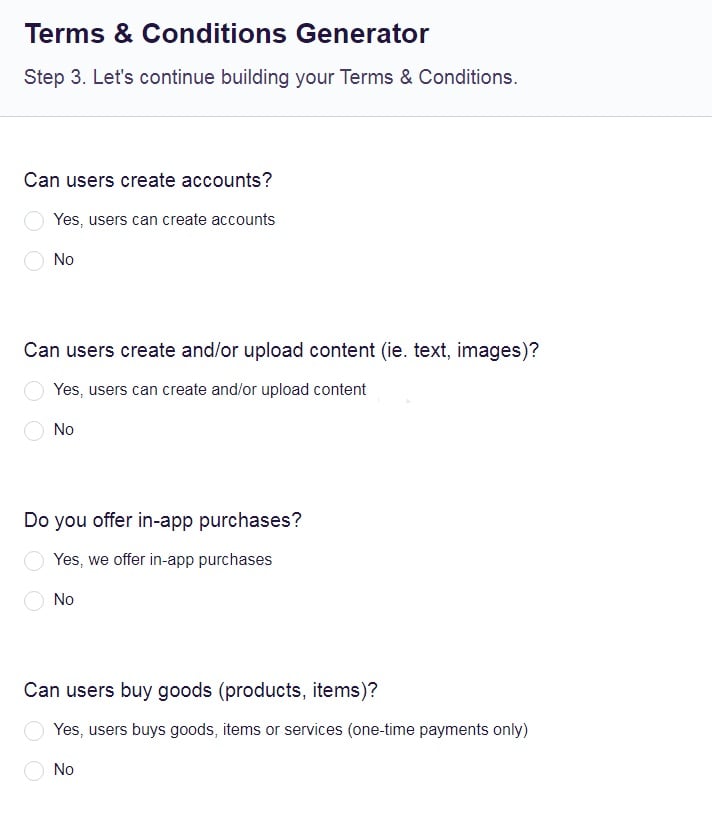
- 1. What is a Terms and Conditions Agreement?
- 2. Why Have a Terms and Conditions Agreement for Memberships
- 3. How to Create a Terms and Conditions Agreement for Memberships
- 3.1. Governing Law and Jurisdiction
- 3.2. Limitation of Liability and Warranty Disclaimer
- 3.3. Payments and Fees
- 3.4. Intellectual Property
- 3.5. Rules and Restrictions
- 3.6. Service Levels
- 3.7. Membership Termination
- 4. How to Display and Get Agreement to a Terms and Conditions Agreement for Memberships
- 5. Summary
What is a Terms and Conditions Agreement?
Simply put, a Terms and Conditions agreement is a set of rules for the relationship between you and a member of your service or program. It's usually a comprehensive document that covers how the relationship works, each side's rights and responsibilities, and how the most likely disagreement or problems are resolved.
In most cases, a Terms and Conditions agreement is meant to cover all your relationships with all your customers. This means it doesn't necessarily cover specifics such as the particular price or what's included in a particular membership. However, you could include these if you only offer one membership package and it's the same for all customers.
Why Have a Terms and Conditions Agreement for Memberships

Having a dedicated Terms and Conditions agreement for your membership program has several important benefits:
- You reduce the chance of a dispute caused by ambiguity or a misunderstanding. Such disputes can eat up time and money even if you are in the right and ultimately win the dispute.
- As long as you have clear terms and conditions and can show the user made an informed choice to agree to them, you have a much better chance of winning any legal case.
- You show you act professionally and fairly and have thought about potential problems.
- You reduce the chances of users trying to act unfairly, for example trying to get the benefits of membership and then avoid paying (or get a refund) by exploiting a loophole.
- You get the opportunity to set the terms you want rather than have to rely on assumptions or negotiation.
How to Create a Terms and Conditions Agreement for Memberships

The following clauses are common in Terms and Conditions agreements. You don't necessarily have to include all of them, but you should think carefully about each one and whether it is relevant to your business.
Governing Law and Jurisdiction
This clause sets out key points about how the law and judicial system interacts with your membership. It normally covers some or all of the following:
- Which country or region's law applies to the agreement and any dispute (the governing law). This should normally be a country or region in which either you or the customer are physically or legally based or where you provide the services.
- Which court system should resolve any dispute. (This is often called the jurisdiction or venue). To avoid confusion, make sure the governing law that you choose applies in the court system that you choose.
- Whether the customer must use dispute resolution (such as arbitration) before starting legal action. You could specify a particular resolution service. You should also say if the outcome of this process is binding on both sides or if either side can reject the outcome and proceed with legal action.
Here's an example of a clause like this, from Civica, that explains that disputes are governed by English laws and settled in English courts:

Limitation of Liability and Warranty Disclaimer
These two concepts are distinct but closely related. You would normally address either or both in your Terms and Conditions agreement to reduce the risk that a court might rule you have a legal obligation by default.
Liability is where you are responsible for something, often physical or financial harm. This could be a result of something you do or something you don't do. A limitation of liability means you are making clear you do not accept responsibility at all, or that you limit liability to a particular amount.
A warranty is effectively a promise. This could be that the product or service you offer is as described, works in a particular way, or achieves a particular goal. A warranty disclaimer means you are making clear that you are not making this promise.
Always check the applicable law in your jurisdiction as you may not be allowed to limit all liability or to disclaim all warranties. For example, the U.S. has a federal law that means products automatically carry an implied warranty that they will work as described. At best, an excessive limitation of liability or warranty disclaimer may be invalid. At worst it could be against the law to include it as this could mislead customers about their legal rights.
Future limits liability and disclaims warranties while making clear it isn't seeking to go beyond what the law allows:
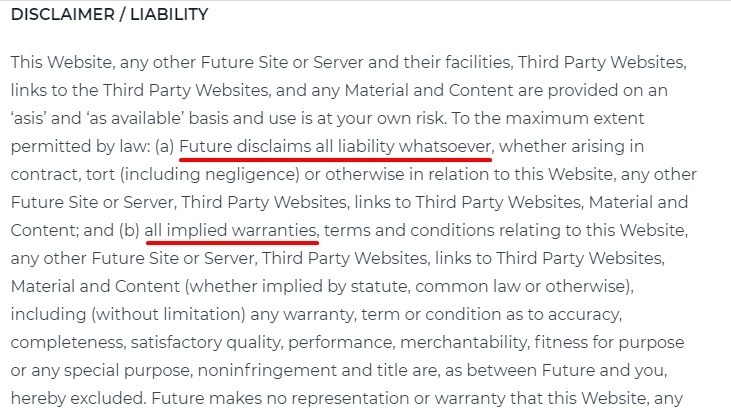
Payments and Fees
This clause addresses how pricing works and how customers pay you. You don't necessarily have to list the specific price here as this could be covered in individual order pages or documents. You should address the following:
- What methods of payment you accept and whether any method carries fees or surcharges
- The deadline for payment and what happens if the customer misses the deadline
- If you sell internationally, which currency the price is based on, how any conversion works, and what happens if the exchange rates changes
You should also address future price changes including:
- Whether you have the right to increase prices
- How often you can increase prices
- Whether prices will go up by a fixed amount, a fixed percentage, in line with a particular method of inflation, or at your discretion
- Whether and how customers can reject a price increase by ending their membership
T-Mobile includes details on taxes and notes that customers agree to pay them:

It also addresses the concept of late payments and how such will be handled:
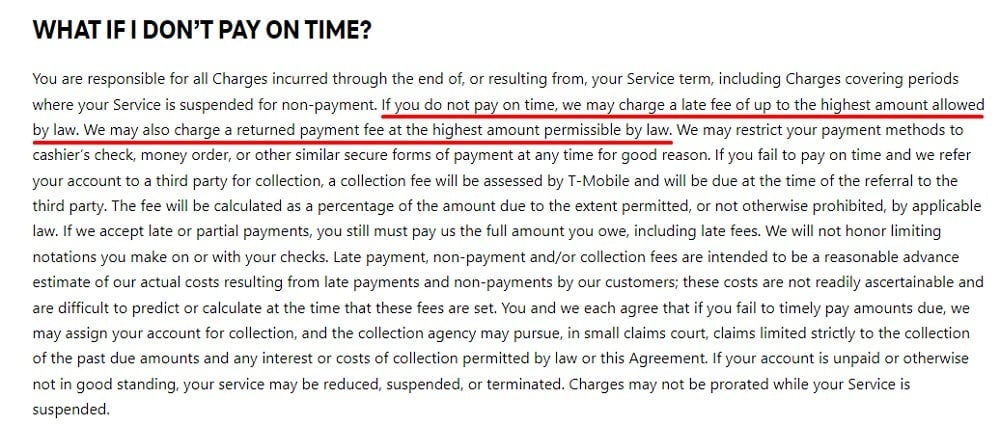
Intellectual Property
Depending on your product or service, you may need to clarify the intellectual property situation. This could involve copyright or trademarks. Points to cover can include:
- You hold the copyright to your content and members cannot share or reproduce it without permission
- You are using some material on a fair use basis. (If so, explain who holds the copyright and the grounds on which your use is lawful.)
- Whether members who upload material to your site retain the copyright to the material. (If so, they must grant you a license to use it.)
- Who holds the copyright to any material members make while using your service, for example with a software subscription
Spotify clearly explains that users retain the rights to content they post, but that they grant a license for Spotify to use it:
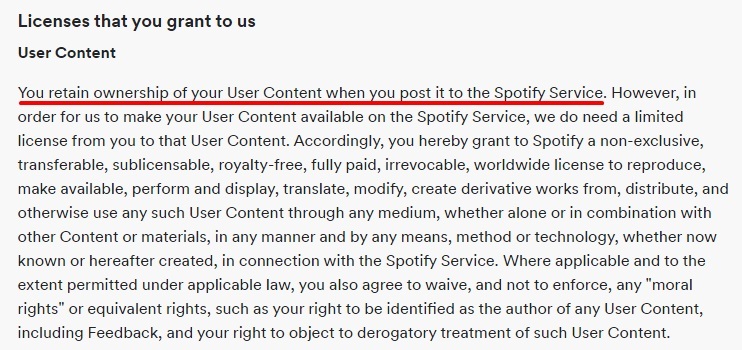
Rules and Restrictions
This clause is effectively a set of rules for the customer to follow when using their membership. Which rules to include will depend on your product or service but generally you should include anything you don't want customers to do. Some banned activities might seem obvious but it's worth including them anyway so that customers cannot argue they were not aware of the rule.
Common examples include rules forbidding customers from:
- Using the product or service to do anything illegal
- Causing harm or loss to you or to other customers
- Allowing non-members to use the service
- Posting offensive or obscene content, for example to a member-only section of a website
Apple clearly states banned actions for users:
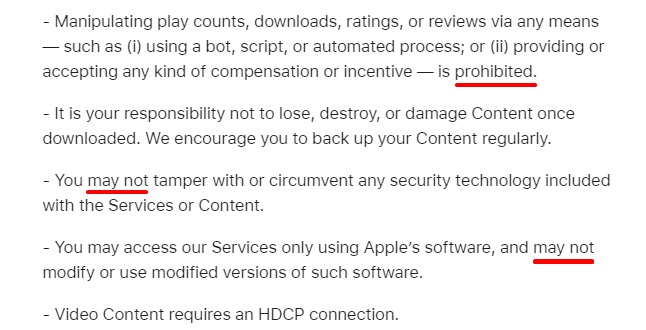
Canva takes a creative approach by giving rules and then explaining the reason for those rules:
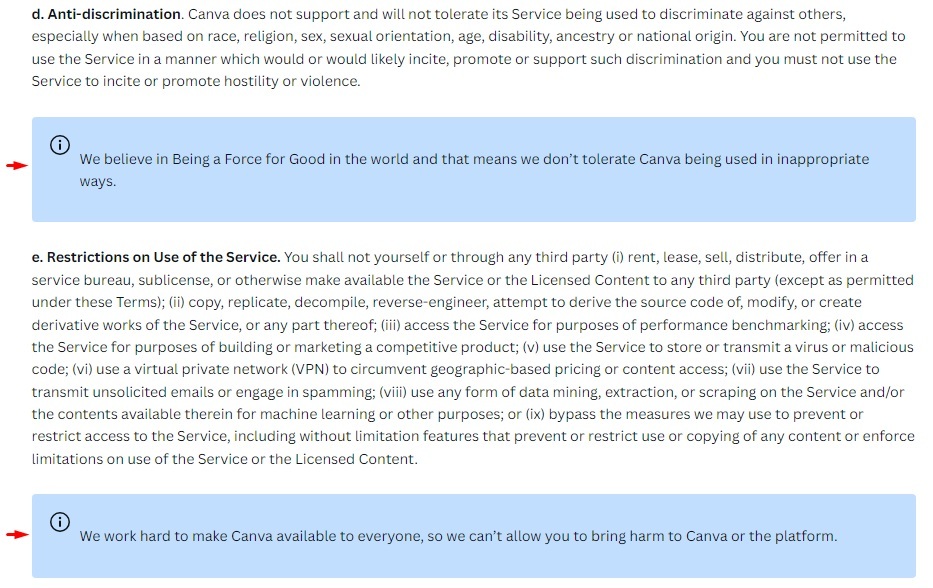
You should also detail the consequences of breaking the rules. This could include:
- One or more formal warnings
- A temporary suspension from using some membership facilities
- A permanent ban with membership withdrawn
- Legal action seeking damages
You should also say whether or not the customer will get a full or partial refund of any membership fees if you suspend or ban them.
Wix uses very formal language but does explicitly cover the key consequences:

Service Levels
This clause details what promises you are making about the service you provide to members. It would normally cover:
- What minimum level of service you promise (for example, availability for a certain proportion of the time, or responding to support requests within a set period)
- What compensation you offer if you fail to meet this level (for example, a partial refund, credit or an extension to the membership period)
- Whether any exemptions apply such as not offering compensation if a natural disaster stops you meeting the service level
Some businesses cover these points in a separate document called a Service Level Agreement. This approach may be more suitable if you offer multiple products or services and your guaranteed service level varies. If you use a Service Level Agreement, make sure your Terms and Conditions agreement mentions this point and explains the two documents work alongside one another.
ServiceNow explains the two forms of compensation it offers:

AskCody details situations where its service level guarantee does not apply:
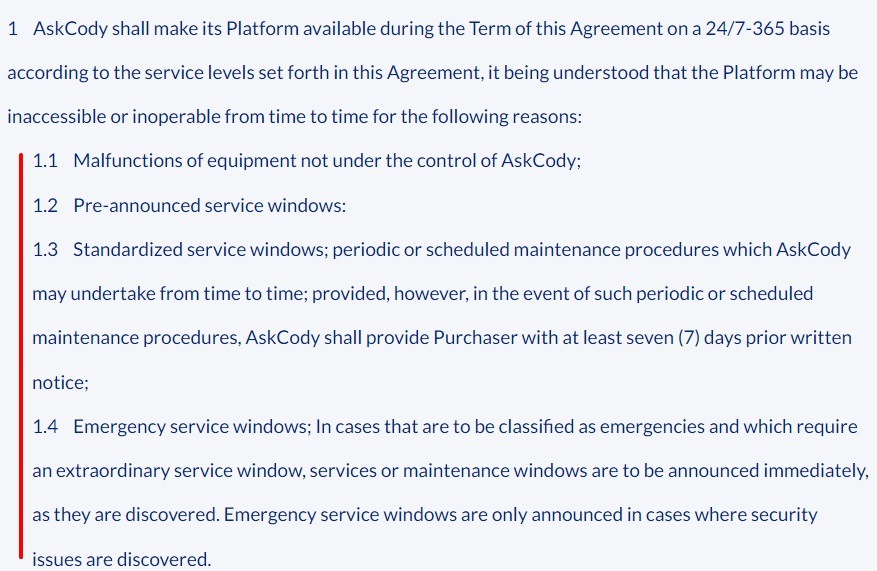
Membership Termination
This clause covers how and when a membership ends. Some common options include the following:
- A fixed-term membership ends automatically unless you both agree to extend it
- A fixed-term membership renews automatically unless the member cancels
- The member can cancel at any time. (Detail any required notice period.)
- You can end the membership for any reason
- You can end the membership if the member breaks any of your terms of use
- You can end the membership if your business stops trading, merges or is taken over
You should also detail what happens when a membership ends. This could include:
- Whether the customer gets any refund
- Exactly when the customer will stop getting the benefits of membership
- What happens to any content the customer has created through the membership such as files or content uploaded to your site or server
- What happens to any equipment you have supplied to the customer through the membership
The Risk Leadership Network details situations where either side could end the membership and situations where it could end the membership:
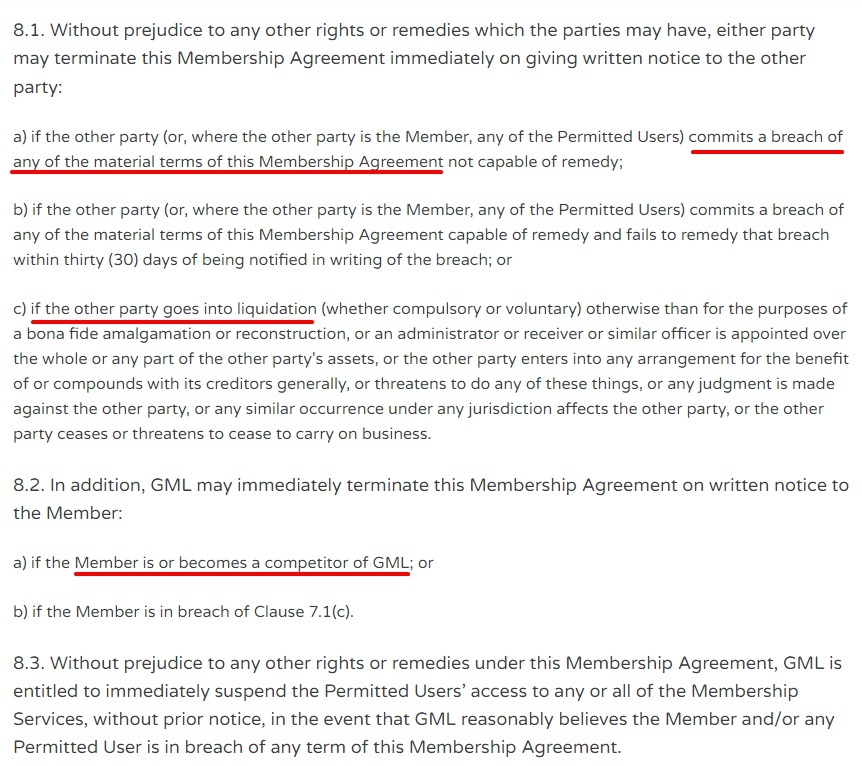
The Open Group makes clear it does not refund money after a membership termination:
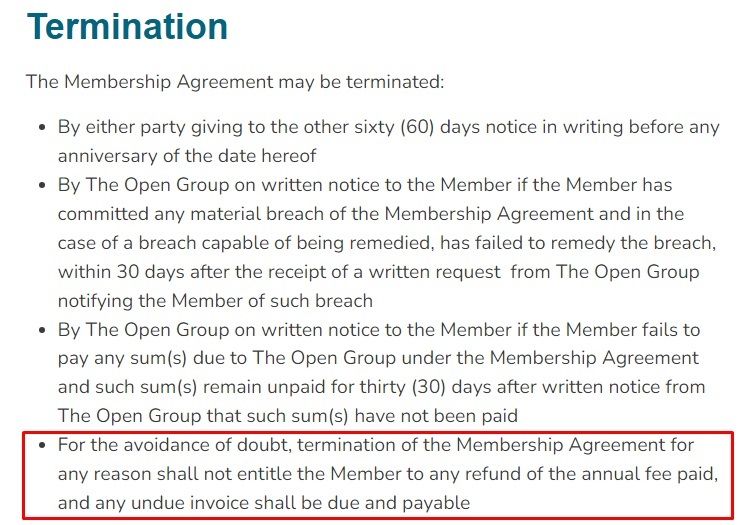
When you have your Terms and Conditions agreement drafted, it's time to display it so the public can view it at any time, either when considering your membership or already a customer. We'll look at that next.
How to Display and Get Agreement to a Terms and Conditions Agreement for Memberships

Because the Terms and Conditions agreement is so fundamental to your relationship, you need to be certain the member has seen and agreed to it. This means you should make it available before the customer takes out a membership and afterwards for easy reference.
Best practice ways to display your agreement include:
- Linked to your website's footer
- In a dedicated legal section on your site, clearly signposted through your navigation system
- At the point somebody is about to sign up as a member
- Through a link contained in any communication with members such as a newsletter
Future PLC has a clear link in its footer menu that appears on every page:
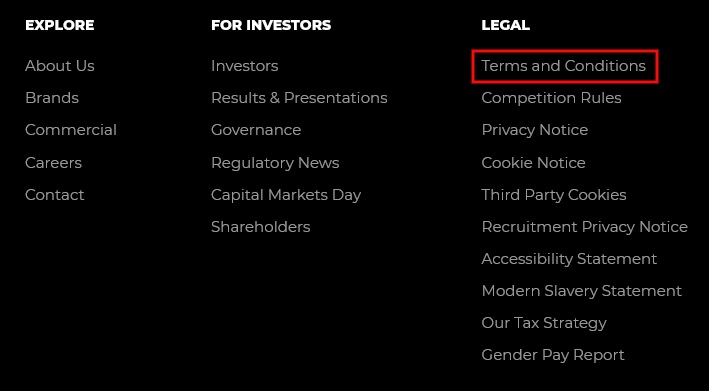
To rely on your Terms and Conditions agreement you may need to prove the member had a fair opportunity to read it and agree to it. For this reason you can't simply assume the member has done so, or say that clicking through to the membership sign-up screen constitutes agreement.
Instead, you need to show they took a positive action to prove consent/agreement. The safest way is to require that they tick a checkbox or switch a toggle before proceeding with the sign-up, and that this box or toggle is clearly marked as indicating the person has read and agreed to the Terms and Conditions. Do not use a pre-ticked checkbox.
Here's an example of a simple setup where users have a clear link to the Terms and Conditions agreement and must then tick the checkbox to agree before they can click the Register button:
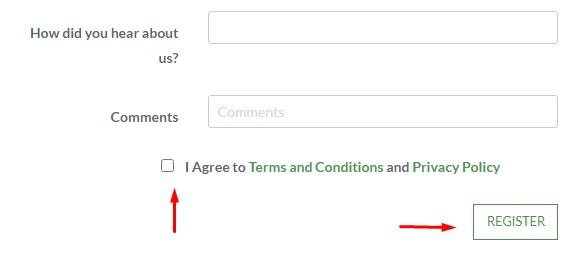
Summary
Let's recap what you need to know about Terms and Conditions agreements for memberships.
A Terms and Conditions agreement sets out rules for the relationship between you and a member. It should reduce the chance of legal disputes as well as strengthening your case if there is a dispute.
This agreement usually includes a range of key clauses addressing common areas of potential dispute or confusion:
- A governing law clause sets out which laws apply to the relationship between you and a member, where any legal action must happen, and whether and how you use alternative dispute resolution such as arbitration.
- A limitation of liability and warranty disclaimer clause sets limits on your responsibility for any damage or loss and what promises you are and are not making about your product or service.
- A payment clause covers issues such as payment deadlines, late fees, and future increases.
- An intellectual property clause sets out who has the copyright or trademarks on various material and what permission they grant others to use it.
- Terms of use are a set of rules about how the member uses the service and what happens if they break those rules.
- A service level clause (sometimes a separate document) details exactly what you are promising about your service and what happens if you fall short.
- A termination clause sets out the different ways a membership can end and what happens when it does.
Display your legal agreement somewhere easily visible and accessible, and get all new users to agree to it when signing up for your membership. You can do this with an I Agree checkbox users must check to show they do in fact agree.
